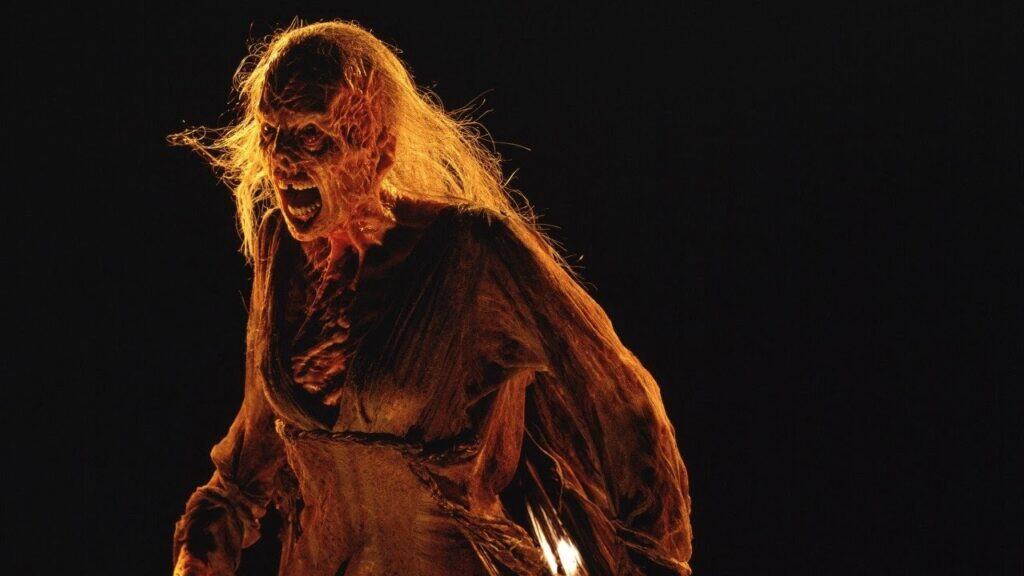Mention Darkness Falls to your fellow horror fans, and you might get two very different reactions. One may scoff, dismissing it as yet another teen jump-scare fest with zero artistic merit. Another might enthusiastically high-five you and say, “I don’t care what anybody says, that movie rules!” The vast difference likely caused by a studio aiming to replicate The Blair Witch Project’s viral marketing success, while making a film more comparable to the modern popcorn horror of Blumhouse or the Conjuring Universe. This is the story of a film with enough lore to fill a novelization, a fake documentary, and a comic book prequel. Reduced to a film so short they had to make the ending credits last eleven minutes long just to be able to release theatrically; a studio that decided to entirely replace the design and appearance of its main villain in POST-PRODUCTION; and finally, this is the story of a girl who had her skin burned off and haunted the whole world. Or at least one small town. This is the story of what happened to Darkness Falls.
Based on a 2001 short film called Tooth Fairy by writer and director Joe Harris. The five minutes long short features a young boy being tucked in by his mother. The kid tucks the tooth away safely in an envelope behind his pillow. There’s a genuinely creepy wing flap that begins to take place outside as he closes his eyes, resisting the urge to peak. When the boy awakens he realizes the alleged tooth fairy is still in his room, standing before him. We know this because he does his best Ben Stiller as Simple Jack in Tropic Thunder face while someone offscreen pelts him with gold coins. Soon though, the shadows engulf him and he screams. His mother comes to check on him and realizes that her son has been attacked. The words “NOT GOOD ENOUGH” are pinned to his chest as the camera pans up to reveal his eyes have been ripped out and stitched back together. Just like the Teddy Bear on his bed.
In September of 2001, Distant Corners Entertainment Group announced the horror short would be turned in their first official film. The company was a subsidy of their parent studio, Revolution Studios, who produced a litany of mid 2000s comedies such as Click, the Daddy Day Care franchise, and White Chicks; as well as other popular films like Rocky Balboa and Black Hawk Down. The film had working titles of both Don’t Peak and The Tooth Fairy before Darkness Falls was settled on, based off of the name of the town where the haunting events take place over centuries.
It’s very easy to see what the studio was thinking in comparison to the horror short that preceded it: “Holy shit, what if the tooth fairy were a horror villain?”. It’s an extremely marketable concept and they didn’t even have to raid the bottom of the barrel, expired Disney-character rights for it. “The Tooth Fairy” as a concept is part of public domain folklore. Meaning, the general idea of the character is open to be used by anyone. To craft a story around her, the studio enlisted the help of the late writer and Tombstone Producer John Fasano. At the time, Fasano had officially written projects Universal Soldier: The Return and Another 48 Hours. He’d also been an uncredited writer on Alien 3 and Alien Versus Predator. Darkness Falls would also be the first film officially written by frequent Radio Silence collaborator, Scream V and Zodiac writer James Vanderbilt.
The duo crafted a story that started in the 19th century and followed a woman named Matilda Dixon who loved children. So much so, that when a child in town lost their tooth, she would give them a gold coin, leading her to be called the….you guessed it….(clip here of Will Smith saying “what are we some kind of Suicide Squad? In Suicide Squad) The Tooth Fairy! A fire in her home ends up horribly disfiguring Matilda’s face. Leaving her, for some reason, extremely sensitive to light. In turn, she wore a porcelain mask to cover her disfigurement. Which kind of made her look like a methamphetamine addict wearing a Party City Michael Myers mask. Scary for us, scary for the children, and ultimately scary for the superstitious townsfolk. Who, ultimately hung her after accusing her of killing two missing kids. Kids that awkwardly showed up again a few days after her lynching. With her last words she promised revenge on the town, cursing Darkness Falls forever.
We then see 90s version of Matilda Dixon, firmly cementing herself as the world’s most f*cked up tooth fairy as she chases young Kyle Walsch around his home. The rules are set quickly, and much like the later released Lights Out by David Sandberg, we learn that the villain’s only Achilles heel is light. But Kyle’s Mom doesn’t know or believe that and is heinously murdered in a banger of an opening scene.
Fast forward again, to twelve years later after the birth of butt rock and Kyle’s now a broken, paranoid man, still afraid of the dark all these years later. Kyle, complete with a full duffel bag full of flashlights and flashlight accessories; must then return to Darkness Falls to help a friend in need.
Behind the camera, the studio looked to first time director Jonathan Liebesman to bring the script to life. The future director of The Texas Chainsaw Massacre: The Beginning had recently won accolades such as the 2000 Hollywood Film Festival’s Young Filmmaker Award for his 8 minute adaptation of short story Genesis and Catastrophe that same year. Writer John Fasanowould later claim in an interview that it wasn’t the debut Liebesman had had in mind. Fasano stated that the director didn’t even like horror movies. That he was simply following his agents advice to make a film for the studio so that they’d then allow him to make one for himself.
The lead role in the film, adult Kyle, would go to relative newcomer at the time, Chaney Kley. Kley had just achieved his first official roles two years previously in the Buffy the Vampire Slayer TV series. Followed by a role in Reese Witherspoon’s Legally Blonde. The actor, who would later be known mostly for a recurring role in the successful TV series The Shield, was clearly capable. And it didn’t hurt that he kind of had an Andrew Garfield look to him, albeit with a darker edge. His career would be sadly cut short though as he tragically passed away just four years later in 2007. The role of his long lost friend and counterpart in the film, Anya, was filled by veteran TV actress and fellow Buffy the Vampire Slayer alum Emma Caulfield Ford. Horror aficionados will also enjoy a Leonardo DiCaprio point at the TV screen moment when they notice that Angus Sampson, or “Tucker” from the Insidious franchise, plays a local idiot drunk who attempts to fight Kyle for a little while before he’s taken to the dentist. Which, in this film, mostly means the Tooth Fairy jump scaring herself onto screen before grabbing someone, disappearing for a moment, and throwing their corpse back into frame. Wolf Creek final girl Kestie Morassi also plays a nurse in the movie, which is more than fitting for a film with such strong Australian ties.
Darkness Falls would be filmed in November of 2001 across Sydney and Melbourne, Australia with a budget of $11 million. Much of which, no doubt went to Special FX, including the many designs of the Tooth Fairy herself. Some of which were due to late script changes. Even post filming. According to special FX creator Steve Wang, who previously worked on the original Predator, their original design for the Tooth Fairy incorporated a “winged and toothy” creature to be performed by the legendary Doug Jones while wearing prosthetics. After unearthing some of the early test footage of Jones in Wang’s angelic, yet gothic, makeup it’s rather hard to understand what the issue was. Luckily, this version was immortalized by McFarlane Toys in 2002 before the company was aware the design had been changed entirely.
Early versions of the script featured a story in which the audience was led to ask the question of whether it was actually the Tooth Fairy committing these murders, or Kyle himself in the midst of a psychotic episode. Handling the film this way, however, led to the Tooth Fairy only being revealed to the audience in the final act. As Emma Cauldfield would later admit, during most of her scenes in the film, she was acting and reacting to nothing at all. Only seeing the creature alongside the audience after the film had been completed.
The studio then enlisted the help of the great Stan Winston to create a tooth fairy monster they could insert into the already finished film. When it came for her full blown face reveal, she was brought to life with an impressive practical puppet designed by Winston and Aaron Sims. The result was one so impressive that to this day it’s hard to believe is not an actual human being wearing prosthetics. According to Puppeteer Jason Matthews, the character was created in post and inserted into the film. Which meant they had the luxury of watching the movie and getting a feel for it beforehand. The result is an awesome movie monster that left my daughter pointing at the screen exclaiming “that look like Freddy Krueger’s wife!” Which is a pretty solid pull, that this writer is kinda proud of. And so should the special FX crew be.
For those looking for an artifact of the once far lengthier and detailed plot, a novelization by writer Keith R.A. DeCandido was published after the film that fills in a lot of the details. The novelization serves as a more faithful adaptation of the original script, spending much more time fleshing out not only the main characters but the backstory of Matilda and better underscores the tragedy of her transformation.

Directed by Jonathan Liebesman
All told, the massive edits and lightening quick pace of the film left it with a running time of only an hour and twenty six minutes. And that’s with over ten minutes of credits! The score was composed by Brian Tyler, who also worked on the most recent Scream sequels, and the soundtrack matched the films mid-2000s vibe as a whole. The song ‘Gunboat’ by Vixtrola is a 90s style banger in hiding that ends the film, and the band Closure, with their single ‘Look Out Below’ could have easily been a Three Days Grace opener back in the day. The soundtrack had a personality that matched the film in that it’s dark and moody but not very deep and only here for a party.
Darkness Falls Producer John Hegeman had been a part of The Blair Witch Project’s genius marketing ploy a couple of years earlier. The marketing that if you don’t remember, included scaring the living sh*t out of us gullible teenagers at the time. In the early years of the internet, when getting your information from TV was still king, the marketing team unleashed a documentary on Syfy which portrayed the tapes found as real found footage. I’ve never been as interested or frightened in the lead up to a movie before. He would try the same tactic here with a faux documentary titled The Legend of Matilda Dixon. Needless to say it didn’t have the same effect. As the saying goes… fool me once… shame on me. Fool me twice. Can’t get fooled again. (Footage of the doc here ). A prequel comic by the original short creator Joe Harris, titled Darkness Falls: The Tragic Life of Matilda Dixon, was also published by Dark Horse Comics in 2002, enriching the lore of Matilda’s story.
Upon the release of Darkness Falls in January of 2003, the marketing efforts still paid off in terms of profit, pulling in a return of nearly $50 million against its $11 million dollar budget. Critically, it was treated almost as badly as Matilda when those kids went missing. The movie was judged harshly. One review quipped “Darkness has fallen and it can’t get up” which, true or not, gets points for creativity. However, the movie may have the last laugh after all.
Darkness Falls is looked back on much more kindly these days. There’s even something of a cult following for the film. Perhaps because we all look back at these fun, rock and roll 2000s horror flicks with less judgement than we did upon their release. Or possibly because with its PG-13 rating and quick pacing it makes for a pretty decent gateway horror flick for a younger audience. Regardless, I think both generations can admit it at the very least starts and ends with a bang. Not to mention a great sound design when it comes to the audio dynamics of the Matilda’s shriek and the film’s many, many jump scares. And that my friends, is what happened to Darkness Falls.
A couple of the previous episodes of What Happened to This Horror Movie? can be seen below. To see more, head over to our JoBlo Horror Originals YouTube channel – and subscribe while you’re there!




